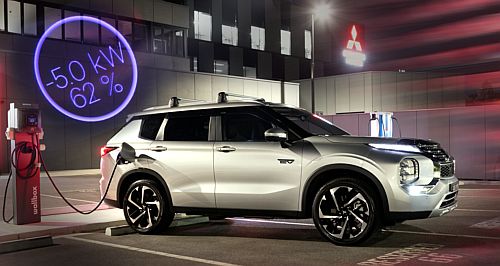News - MitsubishiMitsubishi PHEVs bi-directional charge-readyApproval for Mitsubishi HQ to export energy from PHEVs to grid in South Australia30 May 2024 By COBEY BARTELS and HAITHAM RAZAGUI BI-DIRECTIONAL vehicle-to-home (V2H) and vehicle-to-grid (V2G) charging has made an important step toward becoming a reality for Australians following an approval granted by South Australian grid operator SA Power Networks (SAPN).
Mitsubishi Motors Australia Limited (MMAL) and electrified vehicle infrastructure specialist Jet Charge have obtained SAPN approval to use Outlander and Eclipse Cross plug-in-hybrid (PHEV) models with Wallbox Quasar 1 bi-directional charging equipment at MMAL headquarters in Adelaide.
As the first site in Australia to receive such approval for grid energy exports from vehicle traction batteries – without being subject to trial conditions as is the case with other grid-connected projects – the MMAL setup provides a precedent for other organisations and individuals in South Australia to replicate and submit to SAPN for testing and approval.
Trials conducted in Australia – including the now-approved MMAL setup – use a Wallbox Quasar 1 bi-directional charging unit that costs around $10,000 and has been discontinued until the newer Quasar 2 model arrives later this year.
Jet Charge no longer lists the Quasar 1 through its online store and the company has published the following response from Wallbox: “Quasar 2 is expected to be ready later this year, with a launch date in Australia TBC”.
So far, only South Australia has permitted bi-directional charging to the energy grid and the only vehicles that have been able to do so include Mitsubishi and Nissan vehicles fitted with a CHAdeMO type charging socket, with all other PHEV and battery electric vehicles (BEV) sold in Australia having the more common CCS2 type connector.
Many of these vehicles have vehicle-to-load capability, meaning power can be exported from the traction battery to power a device through an adaptor, but this falls short of building or grid export functionality.
The technology is not exactly new, with the Australian Renewable Energy Agency (ARENA) contributing $2.4 million for a trial of V2G systems back in 2020.
“Since we first announced our head office bi-directional EV infrastructure intentions, MMAL and Jet Charge have been in ongoing consultation with SAPN,” said MMAL eMobility manager Tim Clarke.
“The technology is rapidly emerging, so as SAPN’s operational needs evolved, we worked closely to adapt the installation to ensure grid export requirements were met.”
After completing ‘witness testing’ at MMAL’s head office recently, during which an Outlander PHEV was connected to one of its two Wallbox Quasar 1 bi-directional chargers, SAPN gave the system the tick of approval.
“Under the approval, MMAL is now unconditionally able to export power from its PHEVs into the grid. This achievement further underscores the wide range of ability our Outlander and Eclipse Cross PHEVs offer,” added Mr Clarke.
“As Australia’s V2G landscape continues to mature and access to bi-directional hardware increases, Mitsubishi PHEV owners are well positioned to benefit.”
Various other V2G trials have been undertaken around Australia, but Mitsubishi claims to be the first manufacturer to get the green light for grid exports by SAPN.
Last year, Nissan announced a pilot of its own bi-directional vehicle-to-grid technology using its second-generation Leaf models, also involving SAPN, approved for use at Ballycroft Vineyard and Cellars in South Australia.
The winemaking operation used the V2G technology alongside rooftop solar to eliminate its energy bill and put excess power back into the grid, reportedly taking a $600 bill and turning it into a $50 per week profit.
Although the Nissan Leaf is not yet approved to feed power back into the grid beyond existing trials, MMAL’s approval paves the way for organisations and individuals who have vehicles with CHAdeMO connectors and compatible Wallbox Quasar equipment.  Read more27th of November 2023  Bot sent by Polestar to take on climate trollsPolestar ‘Truth Bot’ takes aim at climate myths spread on Musk’s social media network |
Click to shareMitsubishi articlesResearch Mitsubishi Motor industry news |
















Facebook Twitter Instagram